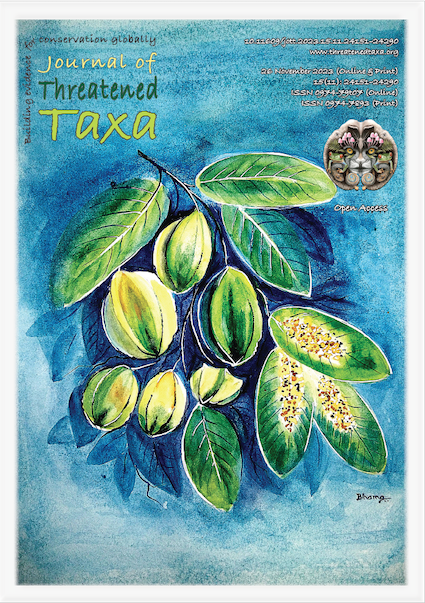First photographic record of Hoary-bellied Squirrel Callosciurus pygerythrus (I. Geoffroy Saint Hilaire, 1832) (Mammalia: Rodentia: Sciuridae) from Banke National Park, Nepal
Main Article Content
Abstract
South Asia’s forest ecosystem is home to a high diversity and endemism of squirrels. The Hoary-bellied Squirrel Callosciurus pygerythrus dwells in patches of dense to moderately dense evergreen forests in mid-canopy temperate, tropical, and subtropical moist habitats including riverine woodland, mixed broad-leaf forest zone, central and eastern Siwalik foothills, Mahabharat range, and modified and altered habitats, settlements as well as farmlands in Nepal. The species is listed under the Least Concern category in the IUCN Red List of Threatened Species. The existing IUCN distribution map does not provide the baseline records or data on the status and distribution of the species in the western part of Nepal. Opportunistic observation was done during anti-poaching field operations and wildlife monitoring work. The current record is the first photographic evidence of the Hoary-bellied Squirrel from Banke National Park.
Article Details

This work is licensed under a Creative Commons Attribution 4.0 International License.
Authors own the copyright to the articles published in JoTT. This is indicated explicitly in each publication. The authors grant permission to the publisher Wildlife Information Liaison Development (WILD) Society to publish the article in the Journal of Threatened Taxa. The authors recognize WILD as the original publisher, and to sell hard copies of the Journal and article to any buyer. JoTT is registered under the Creative Commons Attribution 4.0 International License (CC BY), which allows authors to retain copyright ownership. Under this license the authors allow anyone to download, cite, use the data, modify, reprint, copy and distribute provided the authors and source of publication are credited through appropriate citations (e.g., Son et al. (2016). Bats (Mammalia: Chiroptera) of the southeastern Truong Son Mountains, Quang Ngai Province, Vietnam. Journal of Threatened Taxa 8(7): 8953–8969. https://doi.org/10.11609/jott.2785.8.7.8953-8969). Users of the data do not require specific permission from the authors or the publisher.
References
Aktar, M.W., D. Sengupta & A. Chaudhary (2009). Impact of pesticides use in agriculture: their benefits and hazards. Interdisciplinary Toxicology 2(1): 1–12. https://doi.org/10.2478/v10102-009-0001-7
BaNP (2018). Banke National Park and its Buffer Zone Management Plan 2075/76-2079/80, Banke National Park Office, Ohbari, Banke Nepal. https://dnpwc.gov.np/media/publication/Banke_National_Park_Management_Plan_pdf.
Baral, H.S. & K.B. Shah (2008). Wild Mammals of Nepal. Himalayan Nature, Kathmandu, 158 pp.
Bhandari, S. & M.K. Chalise (2016). People’s attitudes toward Striped Hyaena (Hyaena hyaena) Linnaeus, 1758) (Mammalia: Carnivora: Hyaenidae) conservation in lowland Nepal. Journal of Threatened Taxa 8(9): 9125–9130. https://doi.org/10.11609/jott.2518.8.9.9125-9130
Bhandari, S., C. Morley, A. Aryal & U.B. Shrestha (2020). The diet of the striped hyena in Nepal’s lowland regions. Ecology and Evolution 10: 7953–7962. https://doi.org/10.1002/ece3.6223
Duckworth, J.W. (2016). Callosciurus pygerythrus. The IUCN Red List of Threatened Species 2016:e.T3604A22253451. https://doi.org/10.2305/IUCN.UK.20162.RLTS.T3604A22253451.en. Accessed on 05 September 2023.
Jnawali, S.R., H.S. Baral, S. Lee, K.P. Acharya, G.P. Upadhyay, M. Pandey, R. Shrestha, D. Joshi, B.R. Lamichhane, J. Griffiths, A.P. Khatiwada, N. Subedi & R. Admin (Compilers) (2011). The Status of Nepal Mammals: The National Red List Series, Department of National Parks and Wildlife Conservation, Kathmandu, Nepal, vii + 266 pp.
Karki, R. (2013). Distribution and behavioral ecology of Irrawaddy squirrel (Callosciurus pygerythrus) in urban habitats of Bhaktapur. M.Sc. Thesis. Central Department of Environmental Science, Tribhuvan University Kirtipur, Kathmandu, Nepal, 56 pp.
Koprowski, J.L. & R. Nandini (2008). Global hotspots and knowledge gaps for tree and flying squirrels. Current Science 95(7): 851–856.
Krishna, M.C., A. Kumar, O.P. Tripathi & J.L. Koprowski (2016). Diversity, distribution and status of gliding squirrels in protected and non-protected areas of eastern Himalayas in India. Hystrix 27(2): 111–119. https://doi.org/10.4404/hystrix-27.2-11688
Majupuria, T.C. & R.K. Majupuria (2006). Wildlife and protected areas of Nepal [Resource and Management]. S. Devi. Saharanpur, India, 427 pp.
Mitchell, R.M. (1979). The sciurid rodents (Rodentia: Sciuridae) of Nepal. Journal of Asian Ecology 1: 21–28.
Molur, S., C. Srinivasulu, B. Srinivasulu, S. Walker, P.O. Nameer & L. Ravikumar (2005). Status of South Asian Non-volant Small Mammals: Conservation Assessment and Management Plan (C.A.M.P) Workshop Report. Zoo Outreach Organization/CBSG-South Asia, Coimbatore, India, 618 pp.
Shrestha, T.K. (1997). Mammals of Nepal with Reference to those of India, Bangladesh, Bhutan and Pakistan. Mrs. Bimala Shrestha, Kathmandu, Nepal, 371 pp.
Thapa, S. (2014). A checklist of mammals of Nepal. Journal of Threatened Taxa 6(8): 6061–6072. https://doi.org/10.11609/JoTT.o3511.6061-72
Thapa, S., H.B. Katuwal, S. Koirala, B.V. Dahal, B. Devkota, R. Rana, H. Dhakal & H. Basnet (2016). Sciuridae (order: Rodentia) in Nepal. Small Mammals Conservation and Research Foundation: Kathmandu, Nepal, 70 pp.
Thorington, R.W., J.L. Koprowski, M.A. Steele & J.F. Whatton (2012). Squirrels of the world. Johns Hopkins University Press, Baltimore, Maryland, 459 pp.

